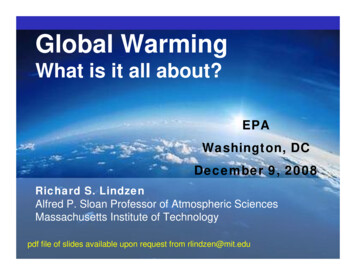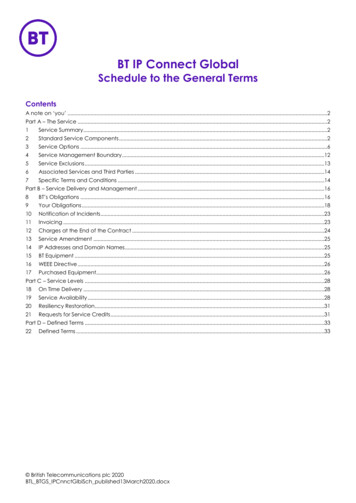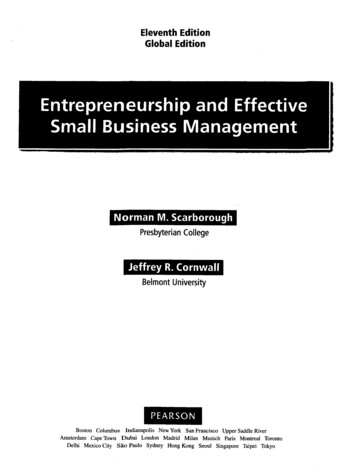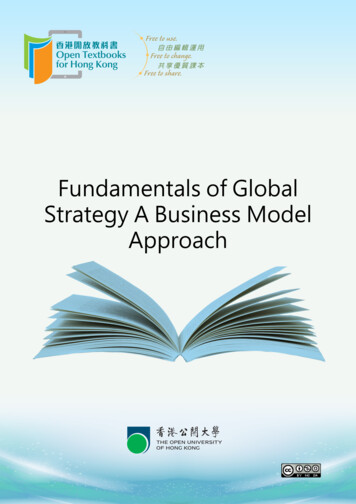
Transcription
Global WarmingWhat is it all about?EPAWashington, DCDecember 9, 2008Richard S. LindzenAlfred P. Sloan Professor of Atmospheric SciencesMassachusetts Institute of Technologypdf file of slides available upon request from rlindzen@mit.edu
Disclaimer (added by EPA)This presentation by Dr. Richard Lindzen on December 9, 2008 hasneither been reviewed nor approved by the U.S. EnvironmentalProtection Agency. The views expressed by the presenter are entirely hisown. The contents do not necessarily reflect the views or policies of theU.S. Environmental Protection Agency, nor does mention of trade namesor commercial products constitute endorsement or recommendation foruse.
The issue of global warming has three distinctcomponents:Global Warming ItselfCatastrophic Climate AlarmismClimate Mitigation PolicyEach of these components is complex and uncertain.The connections between the components are weak to thepoint of non-existence. However, it is characteristic of thistopic to treat them all as equivalent.Page 2
What is Global Warming?The line representsthe actualmeasurements;the purple fuzzrepresents the stateduncertainty. Note thesmall (order 0.6C)overall but irregularwarming since 1900.Page 3
Is this about Global Warming?CO2 and temperature records over the past 650K years as inferredfrom ice cores in Antarctica are often cited as evidence for the roleof CO2 in global climate, but the example is faulty on severalgrounds:1. Correlation is not causality, and here we can see that coolingprecedes the drop in CO2. Higher resolution measurementsshow that warming also precedes CO2 increases.2. Previous interglacials appear to have been warmer than thepresent despite lower levels of CO2.Page 4
Is this what the public discourse is about?In part – but only in relatively small part.In fact, as I have already mentioned, there are three crucial aspectsof the public discourse, and they are largely disconnected.Understanding the nature of these disconnects is more important,I suspect, than understanding the science. However, we need todeal with the components first.Page 5
Aspect 1: Global warming itselfGlobal Warming is, itself, the product of many factors, and itsrelevance to anything else depends on its magnitude. Emissions ofminor greenhouse gases is a factor, but only one factor (andprobably not the most important) among several.What are other factors?The sun is commonly mentioned, but the fact of the matter is thatthe climate system does not need any external forcing tofluctuate on the scale that has been observed. The ocean, byconstantly but irregularly exchanging heat between deeper andshallower regions is always out of equilibrium with the surface, thusserving as a large source or sink of energy for the atmosphere. Inthe literature, this variability goes by names like El Niño, the PacificDecadal Oscillation, and the Atlantic Multi-Decadal Oscillation – allindicative of time scales on the order being considered.Page 6
Don’t forget that climate is always changing – and onvirtually all time scales.Here is a recentpaleoreconstructionfor the past 2000years.Page 7Most presentationsfocus on the last 100years or so (and showthe modest warmingthat we are talkingabout), but in thecontext of the past2000 years, the last100 years do notappear exceptional.Note that we are still talking about smallchanges: much smaller then the normalchange in Boston from the beginning tothe end of April, for example.
April 30, 2008Page 8
What is actually emphasized.While Global Warming issometimes what we hear about,what is usually stressed are‘catastrophic’ or emotionallyaffecting alleged consequences ofwarming.Geneva (Reuters) – Obesitycontributes to global warming,too. May 15, 2008ScienceDaily – Global Warmingmay lead to increase in kidneystones disease. May 15, 2008AP- Earthquakes stronger dueto global warming. June 18,2008NIA- Global warming could leadto increased terrorism. June 26,2008.Page 9
Climate change causes lemming decline. Boston Globe, November 10, 2008Page 10
Aspect 2: CatastrophesPutative catastrophes associated with global warming neverresult from global warming alone, but depend on the confluenceof many factors almost all of which are essentially unpredictable.The catastrophes emphasized in the environmental literature areselected on the basis of marketing research and focus groups –not climate science. Catastrophic forecasts are essentiallyalways wrong (viz predictions of resource depletion, massstarvation, global cooling, Y2K, etc.).Why is this so?Page 11
Impacts as a Chain of InferencesEmissionsRegionalWindPage 12AtmosphericLevelRegionalHumidityThis is an highlyoversimplified descriptionof the chain of inferencesinvolved in calculatingimpacts. The probability ofalmost all the individuallinks is less than 0.5 –usually much less, andother factors can interferewith and confuse erFactorsWhat happens when youmultiply 0.5 or 0.2 byitself 11 times?
Impacts as a Chain of gGlobalResponseThe crucial point isWithout this link (climatethat the catastrophessensitivity), the chain is broken.areRegionalnowhere eRainfallCloudinessbeinga simple Humidityconsequence ofemissions or evenThisis an highlywarming.Page 13oversimplified description of thechain of inferences involved incalculating impacts. Theprobability of almost all theindividual links is less than 0.5 –usually much less, and otherfactors can interfere with andconfuse results.Impact(0.5)11 0.00048828125(0.2)11 0.00000002048OtherFactorsNote that economic linkshave not been included.
Model uncertainty does allow some model to predict anything.Tim Palmer, a prominent atmospheric scientist at the European Centre forMedium Range Weather Forecasting, is quoted by Fred Pearce (Pearce,2008) in the New Scientist as follows: "Politicians seem to think that thescience is a done deal," says Tim Palmer. "I don't want to undermine theIPCC, but the forecasts, especially for regional climate change, areimmensely uncertain." Pearce, however, continues “Palmer . does notdoubt that the Intergovernmental Panel on Climate Change (IPCC) hasdone a good job alerting the world to the problem of global climatechange. But he and his fellow climate scientists are acutely awarethat the IPCC's predictions of how the global change will affect localclimates are little more than guesswork. They fear that if the IPCC'spredictions turn out to be wrong, it will provoke a crisis in confidence thatundermines the whole climate change debate. On top of this, someclimate scientists believe that even the IPCC's global forecasts leavemuch to be desired. .”Page 14
Catastrophic claims never involve a consensus amongscientists.Most scientists working on climate physics agree that storminesswill decrease in a warmer world. Most scientists working onhurricanes agree that Katrina cannot be attributed to globalwarming.Epidemiologists have noted that more lives will be saved fromreduced cold than will be lost to increased warmth. Insect bornedisease specialists note that diseases like malaria were onceendemic to Siberia. Alpine glaciologists largely agree that thediminution of Kilimanjaro’s glacier is not due to warming.Indeed, even the environmental literature switches from claims of‘consensus’ to claims that ‘scientists say’. The difference isimportant but largely missed by most outsiders. In fact thescientists who say such things amount to no more than a handful,and even they usually qualify their statements. In particular, ‘could’generally replaces ‘will.’Page 15
Aspect 3: Mitigation PoliciesAlmost all suggested ‘mitigation’ policies areessentially irrelevant to climate or practically andsome are morally impossible.Kyoto – even if perfectly adhered to – delays whateverwarming might be expected by 2100, by a year or two.No currently known energy source can replace fossilfuels to the extent required to reduce emissions by80%. Nuclear provides a partial out as might currentlyunknown approaches.Current approaches like biofuels, cap and trade, andcarbon offsets may already be leading to hunger,societal instability, and corruption – without reducingemissions at all. Efficiency may be more an aestheticissue than a means of reducing emissions.Page 16
Night time satellite image of the Korean PeninsulaSouth Korea has aboutthe same per capitaemissions as the UK;North Korea’s are about80% less. Is this what wewant?Page 17
Climate change ‘mitigation’ and the developing worldIt has long been recognized that reducing carbon dioxide would ultimatelyprevent the developing world from achieving its legitimate goals.To avoid this in the first instance, developing countries were excused from theKyoto constraints.Nevertheless, the developing world remains sensitive to the dangers of westernclimate policy, and cynical of its real purposes.Thus, Rajendra Pachauri simultaneously endorsed a climate report for theGovernment of India that argues that climate change will not be a problemfor India, while, as head of the IPCC, he preaches that climate change willbring doom and disaster to the rest of the world, and urges the west tobecome vegetarian. Somehow, the cynicism seems remarkably clear tomany – even if the Nobel Peace Prize Committee fails to notice it.Page 18
Combining these three independentlycomplex and uncertain aspects –aspects in large measure unrelated toeach other – into a single ClimateQuestion – and claiming the agreementof all scientists on the matter, is clearlyabsurd. Equally absurd is the claimthat this science is settled.Whether claims that are so obviouslyabsurd can be considered to bedishonest is a matter of judgment that Ileave to you. It is not always an easycall. But, there are things you can lookfor.Page 19
Misuse of language is central to the public discourseFor example, we are currently in a warm period,but there has been no warming trend for over tenyears. Normal year to year fluctuations intemperature do cause some of the years to beamong the warmest in the record, but this hasnothing to do with trends.Keep this in mind the next time you hearsomeone respond to the fact that there hasbeen no trend over the past ten years with theassertion that x of the last y warmest yearsoccurred since 1996.Page 20I suspect that this cessation of warming may alsobe responsible for the tsunami of hystericalclimate propaganda of the past 3 years. Theissue has been prominent for almost ageneration, during which time many agendashave developed. There may be a fear that theseagendas must be achieved now or never.
Another example of semantic confusion.Similarly, it is often claimed that we are now warmer than we havebeen for the past thousand years. Though the claim is almostcertainly false, even if it were true, it would not alter the fact thatcurrent warming is small (indeed much smaller than the models thatare used to project alarm say it should be).Important points to note:1. It is not the amount of CO2 that is important, but the contributionof all anthropogenic greenhouse gases to greenhouse forcing.We are already at about 80% of the forcing that would beproduced by a doubling of CO2.2. There is a pronounced diminishing return for added CO2. Eachaddition produces less forcing than its predecessor.3. There is no physical evidence for a threshold in such a system.Page 21
Some Explanatory notes:1. Diminishing returns for added CO2: As one adds CO2, one rapidlysaturates the centers of radiative absorption bands (akin to theeffect of painting an already blackened window with additionalpaint). The impact of further additions depends more and more onthe weak wings of the absorption bands, leading to a logarithmicrelation whereby each doubling of CO2 leads to the same increasein greenhouse forcing. That is to say adding 280ppmv to 280ppmvleads to radiative forcing of about 3.5 Watts/square meter. At560ppmv, one would need to add another 560ppmv to get another3.5 Watts/square meter.2. Ever more gradual increases in forcing generally are not associatedwith tipping points. More to the point, regional climate changes aregenerally much larger than (and significantly decorrelated from)global means. Tipping points will therefore show up long beforeglobal conditions are appropriate. The absence of such eventsargues against such points for the range of variability beingconsidered.Page 22
Deconstructing the scientific consensus.In support of the assertion of consensus, it is claimed that almost allscientists agree that the earth is warming and that man’s activitycauses warming.If these two items are carefully separated, they do describewhat is agreed on:1. There has probably been warming on the order of 0.5-0.8Cover the past century.2. CO2 is a minor greenhouse gas, whose increase should leadto some warming.This agreement says nothing about1. Whether items 1 and 2 are significantly related,2. Whether the points of agreement have any relation tocatastrophic expectations.Page 23
Some science.For those of you interested in the science, here is an attempt toactually determine the contribution of greenhouse warming to thetemperature record.One begins with the model expectation for the pattern of warming,and then compares this with observations.This picture, which is the usual popularpresentation of the greenhouse effect, is largelyuseless. It ignores the fact that the surface doesnot cool primarily by radiation – rather it cools byconvection and evaporation. The direct radiativeimpact of increased CO2 is concentrated in themid and upper troposphere.Page 24
Possible purpose of previous diagram.Page 25
What models show.Here are very recent results for fourstate of the art models subject to adoubling of CO2 (Lee et al 2007).Despite differences between themodels, all show th
pdf file of slides available upon request from rlindzen@mit.edu EPA Washington, DC December 9, 2008 . Disclaimer (added by EPA) This presentation by Dr. Richard Lindzen on December 9, 2008 has neither been reviewed nor approved by the U.S. Environmental Protection Agency. The views expressed by the presenter are entirely his own. The contents do not necessarily reflect the views or policies of .











